| Title | Image | Summary of text |
|---|---|---|
| Mancy - Drawing from Nature and Without a Teacher | ||
| Mancy - Without - Page 1 |  | The text is a title page indicating the focus on drawing from nature and learning to draw independently, without a teacher. |
| Mancy - Without - Page 3 |  | The text is an introduction to a book titled "Drawing from Nature and Without a Teacher," authored by Adèle V. Le Breton. It describes a method for drawing from nature starting from the very first lesson. The book was published in Paris in 1830, and the author was a student of her father, dedicated to her artistic pursuit. |
| Mancy - Without - Page 4 |  | The text discusses the importance of properly defining drawing before teaching it, as failing to do so results in ineffective instructional methods. Drawing is described as the representation of an object in such a way that it appears real. The text categorizes Drawing, Painting, and Sculpture as branches of the Arts of Drawing that share a common foundation in understanding perspective. |
| Mancy - Without - Page 5 |  | Drawing is vital to arts like architecture, acting as a basis for painting and sculpture. True drawing is defined as the ability to accurately recreate seen objects with correct proportions and expressions. It is argued that true drawing, especially from nature, should be an essential element of education and societal contribution. |
| Mancy - Without - Page 6 |  | The text emphasizes the importance of drawing from nature, rather than copying drawings, as a fundamental educational method. Drawing is presented as a complement to language, especially beneficial for developing intellectual understanding. The author proposes that teaching this method from the first lesson can refine observation and understanding skills, distinguishing their teaching from traditional practices. |
| Mancy - Without - Page 7 |  | The text introduces the principles of drawing from nature, emphasizing the importance of understanding geometry, architecture, and optics. It presents a method for learning to draw without a teacher, focusing on fundamental skills and encouraging observation from life. The text discourages direct copying of illustrations, suggesting they are guides to support hands-on practice with real objects. |
| Mancy - Without - Page 8 |  | The text is an introduction to basic geometry concepts essential for drawing from nature, focusing on fundamental definitions such as points, lines, angles, and surfaces. It explains simple geometric constructions and distinctions between different types of lines and angles. The text serves to bridge standard geometric understanding with practical applications for those learning to draw from nature. |
| Mancy - Without - Page 9 | 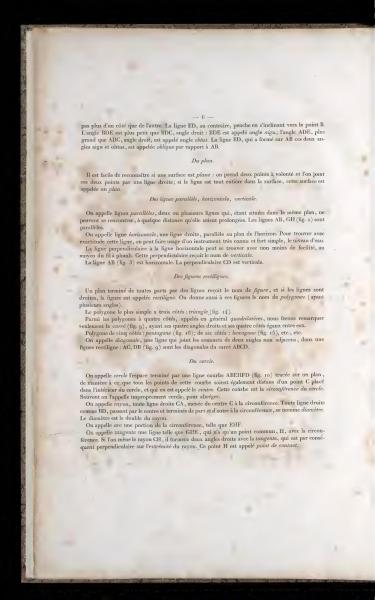 | The text describes geometric concepts, including identifying a flat plane and defining parallel, horizontal, and vertical lines. It explains rectilinear figures, such as triangles and quadrilaterals, and illustrates terms related to circles, including diameter, radius, circumference, arc, tangent, and points of contact. These explanations help in understanding basic geometric principles in drawing and art. |
| Mancy - Without - Page 10 | 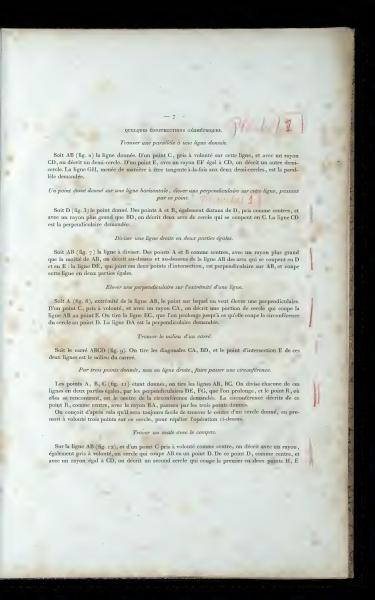 | The text provides methods for basic geometric constructions, such as finding parallel and perpendicular lines, dividing lines into equal parts, finding the center of a square, and constructing circles through given points. Instructions include using arcs and lines to achieve these constructions. Additionally, it describes how to draw an oval using a compass. |
| Mancy - Without - Page 11 | 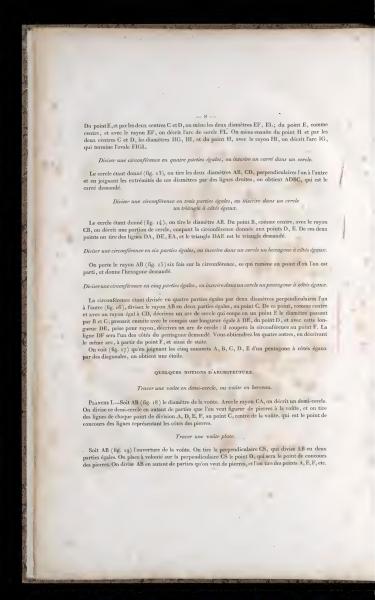 | The text provides instructions on dividing a circle into equal parts and drawing geometric shapes like squares, triangles, hexagons, and pentagons within a circle. It explains the method for inscribing these shapes and includes a section on basic architectural concepts for drawing arches and vaults. Techniques include the use of diameters, radii, and arcs to complete these geometric constructions. |
| Mancy - Without - Page 12 | 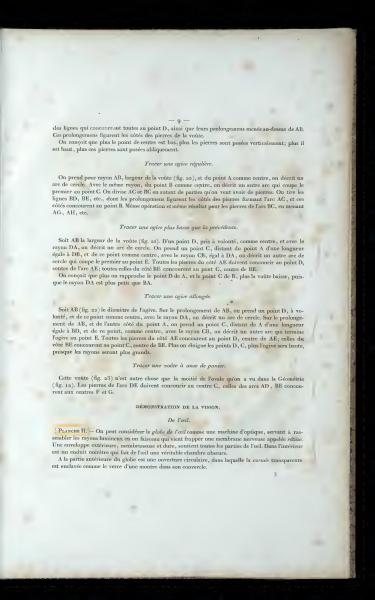 | The page provides instructions for drawing different types of arches and their formations, including regular, lower, elongated, and basket-handle arches, using points and radii as guides. It also includes a brief demonstration of vision, describing the eye as an optical machine that collects light to strike the retina, likened to a camera obscura. |
| Mancy - Without - Page 13 |  | The text explains the anatomy of the eye, specifically the roles of the iris, pupil, crystalline lens, and retina in processing light and forming images. It describes how the eye adjusts to light and translates the external view into an image that ultimately gets interpreted by the brain. Additionally, it provides practical advice for drawing from life, emphasizing the need to use one eye to avoid optical conflicts. |
| Mancy - Without - Page 14 |  | The text discusses the fundamental role of perspective in drawing from nature, emphasizing the importance of learning to see accurately. It uses the example of a square box to illustrate how our eyes perceive objects differently from their actual shape, underscoring the necessity of understanding perspective. The text suggests exercises and methods for accurately capturing what is seen, rather than what is assumed, which is crucial for drawing accurately from nature. |
| Mancy - Without - Page 15 | 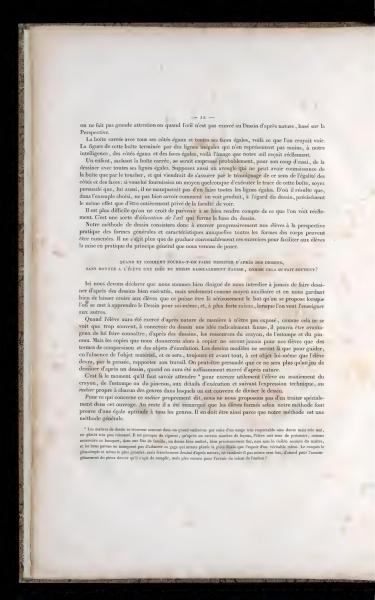 | Drawing effectively relies on training the eye to see real proportions and perspectives, rather than assumptions. Students are first trained in drawing from nature, and then from well-executed drawings to aid in understanding techniques and tools. This approach ensures students develop well-rounded skills in different artistic styles, as supported by a general method. |
| Mancy - Without - Page 16 | 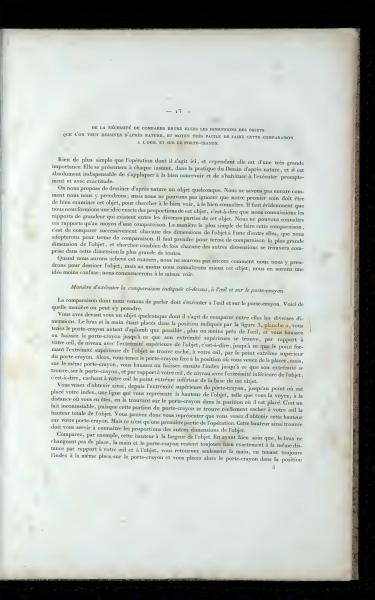 | The text explains the significance of comparing the dimensions of objects when drawing from life. It describes a simple method to perform these comparisons using a pencil holder to measure and align the dimensions, such as height and width, visually. This method aids in understanding the proportions of an object better, necessary for accurate drawing. |
| Mancy - Without - Page 17 |  | The text discusses the application of a previous demonstration regarding measuring proportions using a pencil holder as a tool. It explains how an observer can compare the height of a column's base to its total height through visual alignment and incremental measurement. The explanation details that the base height is one-third of the total height. |
| Mancy - Without - Page 18 |  | This text discusses techniques for accurately measuring and comparing dimensions when drawing from nature. It emphasizes maintaining a consistent distance between the hand and the eye during measurements. Methods are described for using tools like paper strips and rulers to measure proportions and dimensions accurately. |
| Mancy - Without - Page 19 |  | The text explains the concepts of Geometrical Plane and Perspective Plane. A geometrical plane is seen in its true form without distortion, while a perspective plane appears with foreshortening or distortion based on its orientation to the observer. The explanation includes instructions on how to visualize and experiment with these concepts using simple materials like a square of cardboard. |
| Mancy - Without - Page 20 |  | The text discusses perspective in drawing and how an observer’s eye level affects the perception of foreshortening in visual representations. It provides an experimental illustration using cardboard and threads to help understand changes in perspective as the viewing angle changes. The summary reiterates the importance of drawing what one actually sees rather than what one thinks they see, emphasizing the education of the eye in drawing from life. |
| Mancy - Without - Page 21 |  | The text outlines a series of drawing lessons, divided into three main parts: drawing general body shapes, drawing the head, and drawing the entire body or academies from nature. The first part is further divided into five chapters, covering rectangular objects, circular shapes, combination shapes, interiors, and landscapes. The fundamental aspects of linear perspective are emphasized as part of these lessons. |
| Mancy - Without - Page 22 |  | The text advises on how to draw rectangular objects, specifically using a box as a simple model. It discusses the optimal positioning of the artist relative to the object, suggesting a distance of two or three times the object's greatest dimension for a better perspective. The text also explains the concept of geometric and perspective planes and the importance of setting proportions when sketching from nature. |
| Mancy - Without - Page 23 | 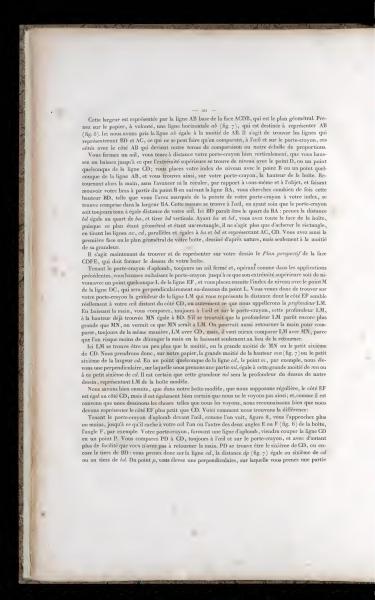 | The text explains a method for representing three-dimensional objects on a two-dimensional plane by using a pencil or similar tool to measure proportions visually. It guides the reader through steps to understand and replicate the dimensions of a box face using geometrical comparison techniques. The importance of comparing depths and sizes for accurate representation in perspective is emphasized. |
| Mancy - Without - Page 24 |  | The text discusses techniques for drawing boxes in perspective, starting with finding specific points and angles, and using them to form geometric shapes. It suggests using plumb lines and pencil holders as tools for visual accuracy. Additionally, it provides steps on how to perceive the elevations and distances between different parts of a box when drawing from nature. |
| Mancy - Without - Page 25 | 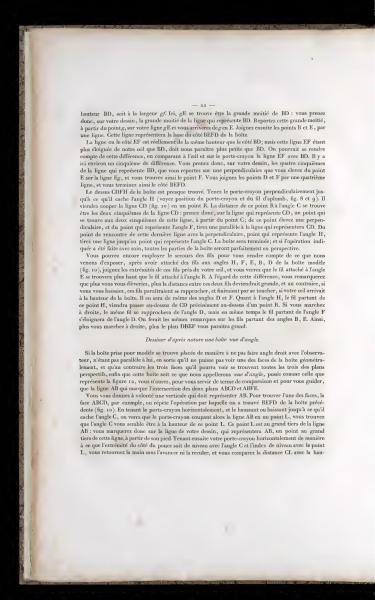 | The text explains the steps for drawing a box with perspective, including measuring distances using a drawing tool. Instructions are given to compare angles and lines with guide threads or pencil holders. It provides detailed methodology for achieving accurate perspective based on a given model. |
| Mancy - Without - Page 26 |  | The text describes a method for drawing a rectangular box using linear perspective techniques. It explains how to find specific points and planes on a drawing to represent different sides of the box. The document concludes by emphasizing the importance of these techniques for drawing not only rectangular but also spherical objects from nature. |
| Mancy - Without - Page 27 |  | The text discusses the importance of perspective as the foundation of drawing from nature, emphasizing concepts such as vanishing lines and the point of view. It explains how these lines appear to converge at a 'point of view' on the horizon line, which is essential in creating realistic drawings. The text also highlights that understanding these concepts is crucial for beginners to avoid intimidation. |
| Mancy - Without - Page 28 | 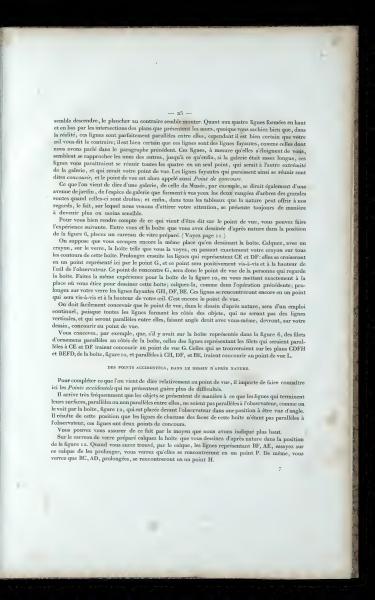 | The text describes how perspective in drawing makes parallel lines appear to converge at a single point, known as the 'Point of Convergence.' An experiment involving tracing on glass demonstrates this effect. Additionally, the text discusses 'accidental points' in perspective, where lines from non-parallel object faces converge at two distinct points. |
| Mancy - Without - Page 29 |  | The text explains the concept of "Accidental Points" in perspective drawing. These points occur when objects are positioned in unusual or varying angles relative to the horizon line, affecting how imaginary lines converge. It describes how different orientations of straight-lined figures influence the location of these accidental convergence points. |
| Mancy - Without - Page 30 |  | This chapter discusses how circles appear as ellipses when viewed from different planes using perspective. It explores how varying the observer's position above a circle influences the degree of foreshortening and changes its appearance from a circle to an ellipse. Practical demonstrations illustrate these changes in perspective, emphasizing the difference in diameters as perceived by an observer. |
| Mancy - Without - Page 31 | 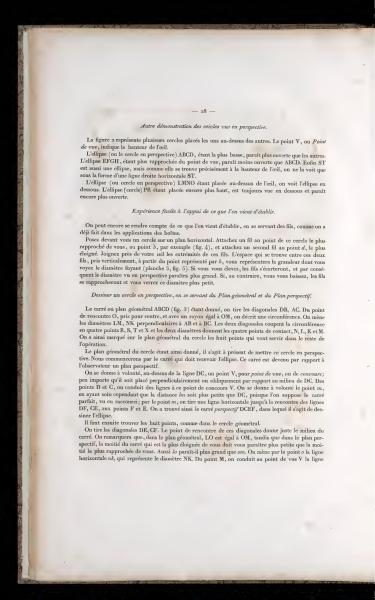 | The text discusses the perspective view of circles placed at different heights relative to the observer's eye. It suggests a simple experiment using threads to demonstrate changes in perspective. Instructions are also provided for drawing a circle in perspective using a geometric and perspective plan. These instructions describe how to visually translate a geometrical circle into a perspective drawing. |
| Mancy - Without - Page 32 | 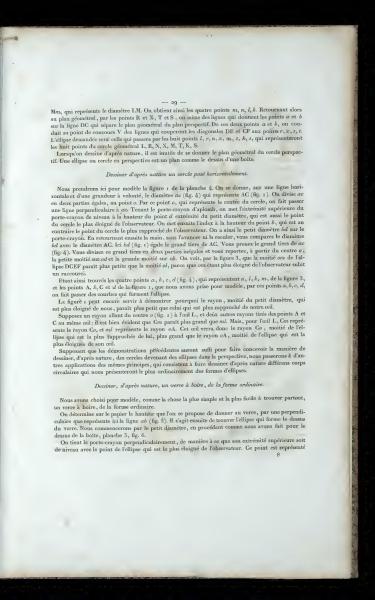 | The text from page 29 provides instructions on drawing circles and ellipses in perspective, explaining the geometric transformations involved when an object is viewed at an angle. It outlines the method of applying these techniques to drawing a drinking glass by accurately representing its circular top as an ellipse. The instructions emphasize understanding and employing perspective principles to achieve realistic representations. |
| Mancy - Without - Page 33 | 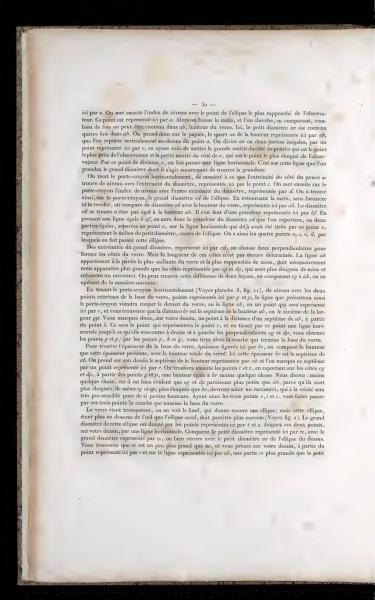 | This passage discusses the detailed process of drawing an ellipse and its components by creating comparative measurements. The instructions guide the reader on using a pencil holder to measure diameters and angles, ensuring precise measurements through a method of divisions and foreshortening. Additionally, it describes the need for adjustments in drawing the base of a transparent glass to achieve accurate dimensional appearances. |
| Mancy - Without - Page 34 | 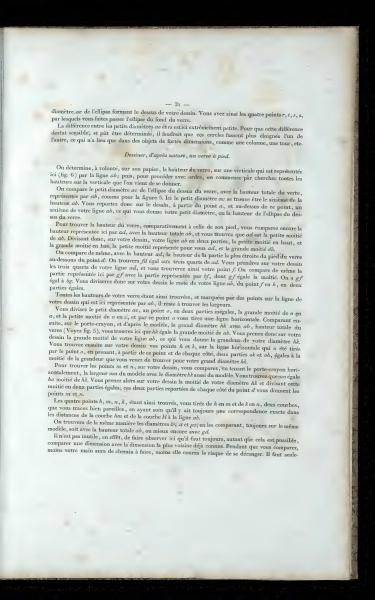 | The text provides a step-by-step method for drawing a wine glass from nature, detailing how to set the glass's height and diameter on a vertical line, comparing various parts to determine proportions. It emphasizes comparing smaller parts of the glass with larger known dimensions to accurately sketch different sections, such as the glass and its stem, by using ratios and repeating these measurements across the drawing. The approach ensures precision by minimizing unnecessary hand movement and stresses the importance of comparing each dimension with the nearest known dimension. |
| Mancy - Without - Page 35 |  | The document provides instructions on drawing a glass from different perspectives, focusing on comparing dimensions to ensure accuracy. It explains how to visualize the elliptical shapes created by liquid in a glass and the importance of holding tools correctly to make these comparisons. Techniques involve ensuring alignment of lines and understanding the observer's viewpoint to render shapes accurately. |
| Mancy - Without - Page 36 |  | The text provides instructions on how to draw objects from nature, focusing on geometric shapes such as ellipses and their perspective. It discusses how to determine the curvature and dimensions of a bottle and explains how this technique applies to other round objects like wells and towers. The approach involves comparing dimensions and utilizing perspective to achieve symmetry and proportion. |
| Mancy - Without - Page 37 |  | This page provides instructions on drawing various structures using ellipses and perspectives, such as wells, towers, and barrels, emphasizing the importance of proportion and point of view. It explains how to depict stones in the well’s walls by using half-ellipses parallel to a main ellipse and discusses foreshortening techniques. Additionally, the text guides viewers on how to draw fountains, tree trunks, and church elements like porches and steeples from life, using previously described methods. |
| Mancy - Without - Page 38 |  | Chapter III discusses combining rectangular and round forms found in nature and applying them to drawing objects like stools and chairs. It explains drawing a stool by first understanding how to draw a box, then applies similar geometric and perspective principles to the stool's structure. The chapter emphasizes utilizing geometric and perspective plans to accurately depict shapes and dimensions. |
| Mancy - Without - Page 39 |  | The text describes how to draw various furniture pieces and a house by observing natural forms and considering different perspectives. It explains drawing techniques for stools, chairs, and tables, highlighting the relationships between geometric shapes and real-world objects. For a house, it suggests seeing the house as a large box and addressing finer details later, emphasizing proportion and perspective. |
| Mancy - Without - Page 40 |  | This text discusses principles of perspective drawing, focusing on how to calculate the height and proportions of a house and its roof. It explains the process of drawing by comparing various elements like windows, doors, and chimneys using geometrical and perspective plans. The methods employ direct comparison and proportional scaling for accurate depiction in drawings. |
| Mancy - Without - Page 41 |  | The text describes techniques for drawing in perspective, specifically for illustrating objects like windows, trees, and columns, and how they appear to diminish in size as distance from the observer increases. It explains how to accurately plot these objects using points, lines, and intersections to replicate real-life diminishment. The instructions can be applied to various objects, demonstrating the principles of perspective in art and geometry. |
| Mancy - Without - Page 42 |  | This text provides instructions for drawing a house from a higher viewpoint, with the observer positioned above the house. It emphasizes using geometric and perspective techniques to accurately depict vanishing lines and proportions. The passage discusses comparing various features like roof height and staircase dimension for precise scale and perspective drawing. |
| Mancy - Without - Page 43 |  | The text defines a "tableau" or picture in two contexts: the objects seen by the observer and the representation of these objects in art. It explains how to draw the interior of a room from nature, emphasizing maintaining a fixed viewpoint. The text stresses understanding perspective to correctly depict spaces and objects within a frame. |
| Mancy - Without - Page 44 |  | The text describes a method for drawing a room as if seen through a transparent glass partition. It outlines a step-by-step guide to accurately determine room dimensions on paper using lines and perspectives, noting proportional relationships and the use of a horizontal pencil for measurements. The drawing starts by defining the main structure before focusing on details, such as windows, ensuring all lines converge at a common viewpoint. |
| Mancy - Without - Page 45 | 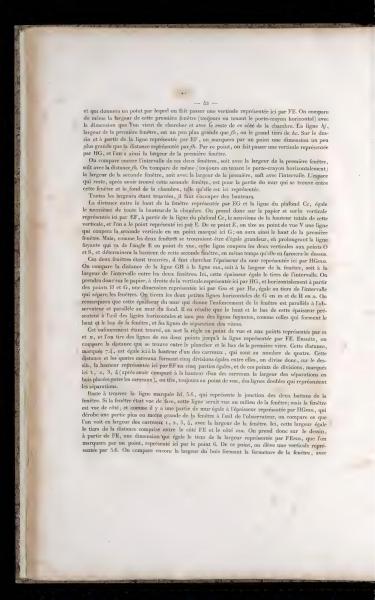 | This text explains how to draw perspectives by using windows and their dimensions as reference points. It details the process of comparing widths and heights of windows within a room, establishing a central vertical reference line, and using a perspective line to determine alignments. The concept includes using grids for accurate drawing proportions. |
| Mancy - Without - Page 46 | 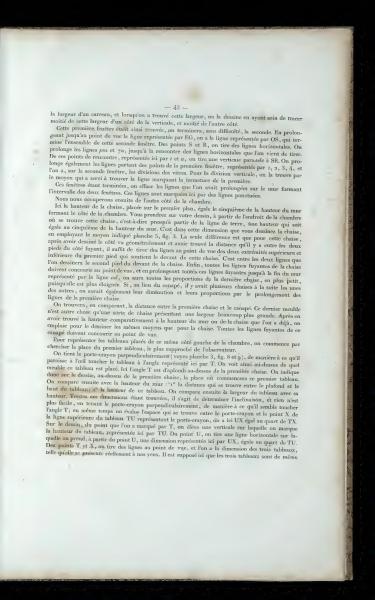 | The text provides detailed instructions on drawing techniques, particularly focusing on using perspective to proportion objects accurately. It describes methods to determine views and drawing intersecting lines to create windows, furniture, and paintings. The described method emphasizes the use of a vanishing point and receding lines for precise rendering in perspective drawing. |
| Mancy - Without - Page 47 |  | The text explains how to use visual comparisons to draw various elements within a room, focusing on paintings, the fireplace, and the carpet using principles of perspective. It details how to measure and compare dimensions for these components to keep consistency and perspective. Techniques include checking alignments with vertical and horizontal lines and drawing ellipses and circles in perspective. |
| Mancy - Without - Page 48 | 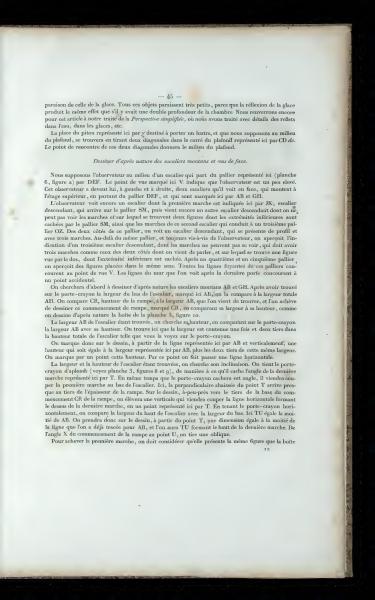 | The text describes the process of drawing stairs as observed from different perspectives, focusing on ascending and descending staircases. It gives specific instructions on how to measure and interpret the dimensions and angles of the stairs using a pencil as a tool for comparison. The goal is to accurately convey the visuals and perspectives of staircases in a drawing. |
| Mancy - Without - Page 49 |  | The passage describes how to draw a descending staircase from nature, focusing on how objects appear according to perspective rather than their actual form. It explains that even though a staircase descends, its steps appear at varying heights depending on the viewer's perspective. There's also mention of using prepared glass for tracing to confirm this perspective. |
| Mancy - Without - Page 50 | 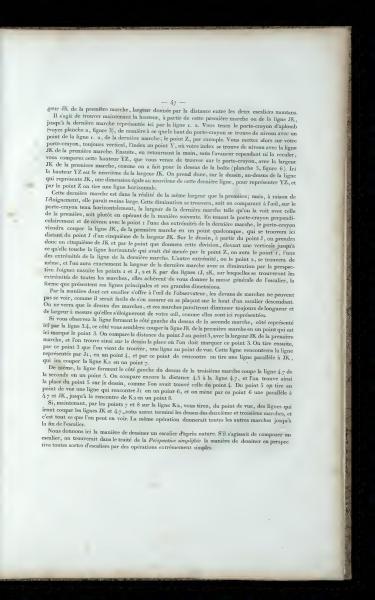 | The text explains a method for drawing stairs from nature, detailing how to measure and represent the height and width of steps through perspective drawing. It also discusses the optical illusions encountered when viewing steps in a drawing versus reality, and the importance of accurate measurements to ensure visual correctness. The text ends by mentioning that the treatise on simplified perspective provides straightforward methods for drawing different staircases. |
COPYRIGHT © 2024 STUDY DRAWING. ALL RIGHTS RESERVED.